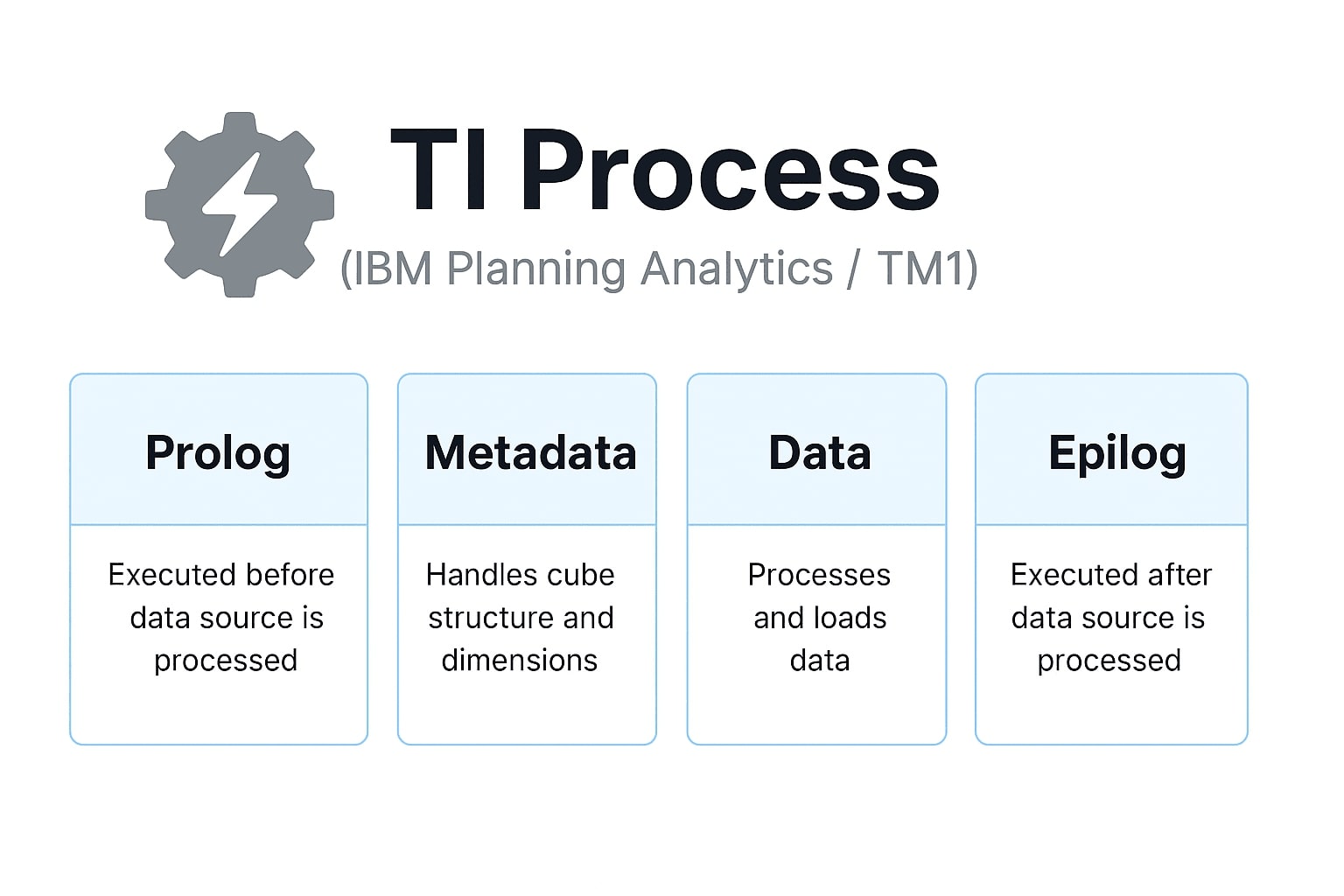❤️Unveiling the Engine: Understanding the TI Process in IBM Planning Analytics
Discover how the TurboIntegrator (TI) Process powers IBM Planning Analytics. A comprehensive guide for Gen Z consultants and data-driven decision-makers.


Introduction: The Hidden Engine Behind IBM Planning Analytics
In today’s digital consulting landscape, especially for Gen Z professionals entering enterprise environments, there’s often one unsung hero behind many data-driven insights: the TI Process in IBM Planning Analytics (TM1).
This blog aims to demystify the TurboIntegrator (TI) — the process engine that quietly powers complex data transformations, automations, and business logic behind the scenes. Understanding TI is not just for techies — it’s mission-critical for consultants, analysts, and future-focused business leaders who want to master IBM Planning Analytics.
“TurboIntegrator is to IBM Planning Analytics what a heart is to a human body — silent but vital.”
🔍 What is the TI Process?
The TurboIntegrator (TI) is a scripting engine and ETL tool within IBM Planning Analytics. It enables developers and consultants to import, manipulate, and automate data from various sources into the TM1 environment.
🕵️♂️ Why It Matters:
- Automates data loads and transformations.
- Builds and maintains metadata (dimensions, cubes, hierarchies).
- Applies business logic, validations, and calculations.
- Enables scalable, reusable process flows across environments.
It’s the core engine that ensures data integrity, reliability, and automation in enterprise applications.
4️⃣ The 4 Pillars of TI Process

Every TI process is divided into four key tabs or stages, each with a specific purpose:
| Tab | Purpose |
|---|---|
| Prolog | Initialization logic before data processing begins |
| Metadata | Dimension and hierarchy creation during the data read |
| Data | Row-level data handling and business rules |
| Epilog | Final actions after data processing (logging, email triggers, etc.) |
Understanding when and how to write code in each tab is essential for optimized and predictable outcomes.
🤝 Common Use Cases of TI
-
Data Load from External Sources Load sales, finance, HR, or operational data from CSV, ODBC, or APIs into TM1 cubes.
-
Dimension Automation Build or update customer segments, product categories, or cost centers programmatically.
-
Business Logic Automation Implement multi-step calculations, data validations, or workflow updates.
-
Scheduled Tasks Automate tasks like cube backups, rule deployment, or data refreshes on a cron-based scheduler.
👉 Real-World Example: Monthly Sales Data Upload
Here’s a simplified use case:
- Goal: Load monthly sales data into the TM1
SalesCube. - Source: A CSV file from an FTP folder.
- TI Logic:
- Prolog: Clear the cube slice for the current month.
- Metadata: Create any missing customer or product dimension elements.
- Data: Write records into the cube using
CellPutN(). - Epilog: Send a completion email to the business owner.
This use case is common in many enterprise TM1 implementations and demonstrates the power and simplicity of TI scripting.
👍Best Practices for Gen Z Consultants
The best consultants don’t just write scripts — they engineer clarity and confidence into every process.
✅ Start with Clear Objectives Before writing any TI process, document:
- What is the source?
- What is the target?
- What validations are required?
✅ Modularize the Logic Break logic into reusable subprocesses. For example, separate processes for dimension building and cube population.
✅ Use Parameters Wisely
Use Process Parameters (pDate, pVersion, pFilePath) to make your TI scripts dynamic and reusable.
✅ Comment Everything Good commenting is future-proofing. A future consultant — maybe you — will thank you later.
🔧 Debugging & Logging Tips
Even the best scripts fail sometimes. Here’s how to troubleshoot like a pro:
- - Use
ASCIIOutput()to log critical variables to external files. - - Write to control cubes for audit trails.
- - Use conditional breakpoints with
IF()blocks to isolate logic.
“A clean log is a happy life.”
TI Process vs. Other Automation Tools
| Feature | TI Process | Excel Macros | Python Scripts |
|---|---|---|---|
| Native to IBM PA | ✅ Yes | ❌ No | ❌ No |
| Scheduler Integration | ✅ Yes | ❌ Manual | ✅ With external tools |
| Data & Metadata Sync | ✅ Tight | ❌ Limited | ✅ But not native |
| Role-Based Security | ✅ Inherent | ❌ None | ✅ With effort |
TI remains the most secure and native automation engine inside IBM Planning Analytics.
🧠 Closing Thoughts: Embrace the Engine
If you're entering the world of enterprise analytics, especially as a Gen Z consultant, TI isn’t just a technical skill — it’s a competitive advantage.
Just like Sanatan Dharma teaches us the importance of underlying order and dharma, understanding the underlying logic behind your data models gives you a massive edge in delivering clarity, automation, and transformation.
Mastering TI means mastering the pulse of IBM Planning Analytics — and that makes you not just a developer, but a true architect of business intelligence.
🚀 Final Takeaways:
- TI is not just a scripting tool; it’s the backbone of Planning Analytics.
- Break down processes into modular, parameterized, and well-commented scripts.
- Use logging and debugging proactively to build confidence.
- Think beyond data loads — TI enables automation, integrity, and intelligence.
“The unseen process is often the most powerful. Like dharma, TI runs quietly beneath the surface — aligning the business world with balance, speed, and wisdom.”